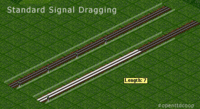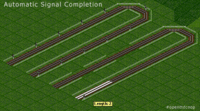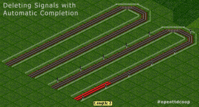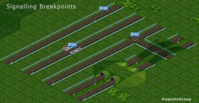Signals
From #openttdcoop wiki
| This article may need to be updated. Please update this article to reflect recent events or newly available information, and remove this template when finished. Please see the talk page for more information. |
See also: http://wiki.openttd.org/Signals
Contents
Signal types
OpenTTD currently has 4 basic signal types (not counting presignals). These 4 are:
Each of these 4 signal types has different properties and should be used in different circumstances. An overview:
| Signal | Type | Direction | Comments |
|---|---|---|---|
| Standard single | Block | One-way | The standard signal for one-way tracks, and therefor the most-used signal in coop games. |
| Standard double | Block | Two-way | Arguably the hardest signal to use properly. Standard double signals have an EOL property that means that if they are red, the pathfinder considers the signal the End Of a Line, thereby discaring its route. This property can lead to very unexpected and unwelcome behaviour. Use with caution. |
| PBS 1-Way | Path-based | One-way | The bath-based version of the standard single signal. In general, use this instead of the PBS signal. However, whenever path-based signals are nog strictly needed, use the standard single signal instead. |
| PBS | Path-based | Two-way | While this path-based signal can be driven two-ways, it does have a preference for one direction. This preferred driving direction is indicated by the single signal pole and is the same as with the PBS 1-Way. Driving a PBS signal the wrong way gives a massive penalty in the pathfinder. This is the reason why we commonly use the reversed versions of these signals as penalties in our games. |
The two block signals themselves have specific versions, called pre-signals. More about those can be found in Presignal Basics. Path-based signals themselves have their own unique features, which are detailed here.
Placing Signals
Before you start to use Automatic Signalling or Signal Dragging you should check the signal density. You can change it in the signal interface or edit the drag_signals_density value in your openttd.cfg. Make sure the value is set to two.
Basic Signalling
The first thing you should know is how use the basic signal dragging feature of OpenTTD: Build a signal (fastest Shortcut is A & S), left-click it and hold the button, drag it as far as you want to build signals. Release the button and the signals will be built. Very easy.
Automatic Signal Completion
Now we are ready to build signals and know how to use the basic feature of dragging. We can go a step further. Again Build a signal and drag it. While you are dragging it a little bit press the CTRL button and release it. The track will be filled up with signals until a breakpoint which are existing signals on the track, stations and junctions.
Removing Signals
It's also possible to remove Signals with the Automatic Completion feature. If you have build a track with signals, use the signal deletion function (Shortcut: A & S & R): click the signal, drag it while pressing the CTRL button and all the signals will be deleted. The breakpoints are stations and junctions.
Breakpoints
Automatic Signal Completion won't stop at: Tunnels and Bridges but stops at: Junctions, Stations and Existing Signals
Checking anyway
After you have "signaled" a track, you should optimize signaling at junctions, they might need a signal right before or after the interruption to avoid signal gaps.
Two-way signals
Two-way signals are a common way to influence trains on coop servers. This is possible with the setting Two-way end of line.
Two-way end of line
Two-way end of line is a setting in OpenTTD that can be altered to create interesting train behaviour. By default it is off, but it is activated on every openttdcoop server. A red two-way signal directs train to a different route if one is available.
Read more: http://wiki.openttdcoop.org/Two-way_end_of_line
Presignals
Presignals are widely used in openttdcoop games for simple constructions as well as the most advanced ones.




